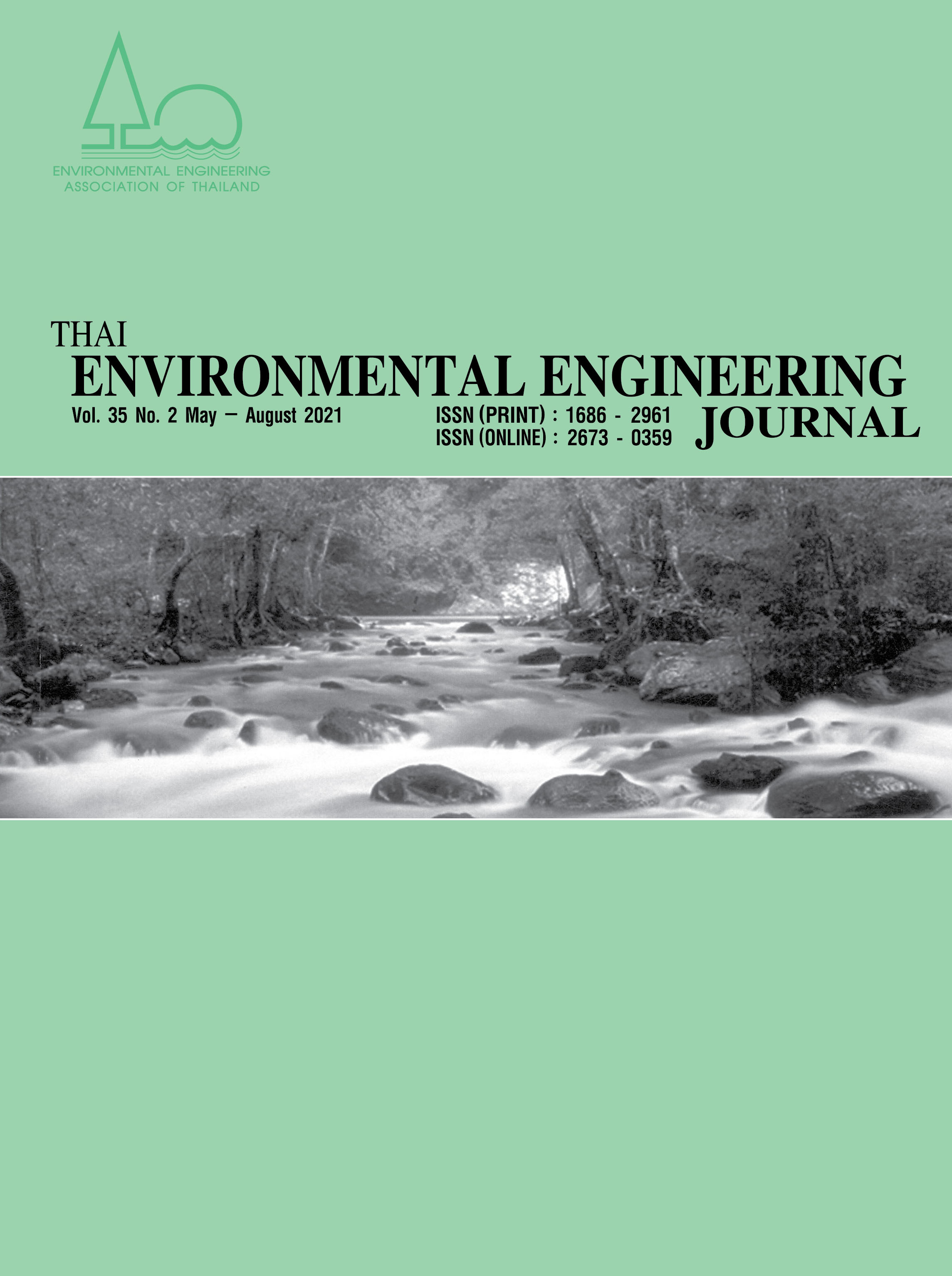Comparison of Specific Anammox Activity and Nitrous Oxide Production of Enriched Anammox Cultures in Suspended-and Attached-Growth Systems
Main Article Content
Abstract
Anaerobic ammonia oxidizing (anammox) bacteria are able to remove nitrogen in both attached-and suspended-growth systems. Attached-growth or biofilm systems are better able to handle high nitrogen loading (total nitrogen concentrations (NH4+-N plus NO2---N) up to 80.5 mM) than suspended-growth systems. High nitrogen concentrations (along with constant concentrations of minor nutrients and trace elements) were fed to enriched anammox cultures in suspended-and attached-growth systems, contained in sequencing batch reactors (SBRs). For attached-growth a polystyrene sponge was used as the growth medium. The specific anammox activity (SAA) with attached-growth systems was higher than the SAA for suspended-growth systems. Nitrous oxide (N2O) production was significantly greater in both reactors at pH 6.8 than at pH 7.3, 7.8, and 8.3. N2O production from both reactors was significantly higher at an NH4+:NO2- ratio of 0.5:1 than at ratios of 0.75:1, 1:1, and 1:1.3. However, N2O production from the attached-growth system was slightly lower than N2O production from the suspended-growth system. The results from this research suggest that attached-growth reactors could provide operational advantages over suspended-growth reactors in field applications.
Article Details
References
Kartal, B., van Niftrik, L., Keltjens, J. T., Op den Camp, H. J. M., & Jetten, M. S. M. (2012). Anammox-Growth Physiology, Cell Biology, and Metabolism. In Advances in Microbial Physiology (1st ed., Vol. 60). Elsevier Ltd.
Ravishankara, A. R., Daniel, J. S., Portmann, R. W. 2009 Nitrous Oxide (N2O): the Dominant Ozone Depleting Substance Emitted in the 21st Century. Science 326(5949): 123-125.
Schalk-Otte, S., Seviour, R. J., Kuenen, J. G., Jetten, M. S. M., 2000 Nitrous oxide (N2O) production by Alcaligenes faecalis during feast and famine regimes. Water Res. 34(7): 2080-2088.
Kampschreur, M. J., Temmink, H., Kleerebezem, R.; Jetten, M.S.M.; van Loosdrecht, M.C.M. 2009. Nitrous oxide emission during wastewater treatment. Water Res. 43, 4093-4103.
Wunderlin, P., Mohn, J., Joss, A., Emmenegger, L., and Siegrist, H. 2012 Mechanisms of N2O Production in Biological Wastewater Treatment under Nitrifying and Denitrifying Conditions, Water Res. 46 1027-1037.
van Dongen, U.; Jetten, M.S.M.; van Loosdrecht, M.C.M. 2001 The SHARON®-Anammox process for treatment of ammonium rich wastewater. Water Sci. Technol., 44, 153-160.
Isaka, K., Date, Y., Sumino, T., Yoshie, S., Tsuneda, S., 2006 Growth characteristics of anaerobic ammonium-oxidizing bacteria in an anaerobic biological filtrated reactor. Appl. Microbiol. Biotechnol. 70, 47-52.
APHA 2005 Standard Methods for the Examination of Water and Wastewater, 21st ed. American Water Works Association and Water Environmental Federation, ashington, DC, USA.
Sobotka. A. Tuszynska. P. Kowal. S. Ciesielski. K. Czerwionka. J. Makinia. 2017 Long-term performance and microbial characteristics of the anammox-enriched granular sludge cultivated in a bench-scale sequencing batch reactor. Biochem. Eng. J., 120, 125-135.
Egli, K., Bosshard F., Werlen C., Lais P., Siegrist H., Zhender A.J.B., vad der Meer J.R., 2003 Microbial composition and structure of a rotating biological contactor biofilm treating ammonium-rich wastewater without organic carbon. Microbial Ecology, 45, 419-432.
Schulthess, R. V. and Gujer, W. 1996. Release of nitrous oxide (N2O) from denitrifying activated sludge: verification and application of a mathematical model. Water Res. 30(3): 521-530.
Chung, Y. C. and Chung, M. S. 2000 BNR test to evaluate the influence of C/N ratio on N2O production in biological denitrification. Water Science and Tech. 42(3): 23-27.
Tallec, G. Garnier, J., Billen, G., Gousailles, M. 2006 Nitrous oxide emissions from secondary activated sludge in nitrifying conditions of urban wastewater treatment plants effect of oxygenation level Water Res. 40(15): 2972-2980.
Kampschreur, M. J., Wouter, R. L., Star, van der, Wielders, H. A., Mulder, J. W., Jetten, M. S. M., and van Loosdrecht M. C. M. 2008a Dynamics of niric oxide and nitrous oxide emission during full-scale reject water treatment. Water Res. 42, 812-826.
Park, K. Y.; Inamori, Y.; Mizuochi, M.; Ahn, K. H. 2000 Emission and control of nitrous oxide from a biological wastewater treatment systems with intermittent aeration J. of Biosci. and Bioeng., 90(3): 247-252.
Strous, M., Heijnen, J. J., Kuenen, J. G., Jettten, M. S. M. 1998 The sequencing batch reator as a powerful tool for the study of slowly growing anaerobic ammonium-oxidizing microorganisms. Appl. Microbiol. Biotechnol. 50(5): 589-596.
Kampschreur, M. J., Tan N. G. G., Kleerebezem, R., Picioreanu, C., Jetten, M. S. M., van Loosdrecht, M.C.M. (2008b) Effect of dynamic process conditions on nitrogen oxides emission from a nitrifying culture. Environmental Science and Technol. 42(2): 429-435.


